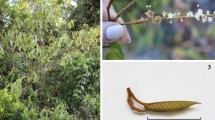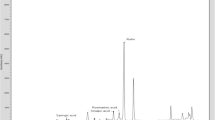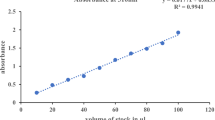Abstract
Croton is a large genus of Euphorbiaceae and many of its species are used medicinally. This study was performed to analyze the flavonoid composition and the antioxidant potential of hydroalcoholic extracts of nine Argentinian species of Croton: C. andinus Müll. Arg.; C. argentinus Müll. Arg.; C. catamarcensis Ahumada; C. cordobensis Ahumada; C. curiosus Croizat; C. lachnostachyus Baill.; C. lanatus Lam. var. lorentzii (Müll. Arg.) P.E. Berry; C. saltensis Griseb.; and C. serratifolius Baill. Few investigations studying the analyses of flavonoid glycosides in Croton have been carried out. The hydroalcoholic extracts (80 % methanol) from leaves were analyzed by high-performance liquid chromatography–mass spectrometry. The antioxidant activity was analyzed by the 1,1-diphenyl-2-picryl-hidrasil, Sigma (DPPH), ferric reducing antioxidant potential (FRAP), and Folin–Ciocalteu methods. O-Glycosides of flavonols (kaempferol, quercetin, and isorhamnetin) and flavones (apigenin) were ubiquitous in the analyzed samples. Rutin was frequent and predominant, especially in Adenophylli section. Acylglycosides of either quercetin or kaempferol (tiliroside) were detected in most samples. C. argentinus and C. serratifolius were the species with the highest antioxidant capacity and the highest total content in proanthocyanidins and total phenols together. Significant degree (P < 0.05) of correlation was found between relative abundances of total phenols, proanthocyanidins, and quercetin derivatives, with FRAP and DPPH. Principal Component analysis showed a close affinity among Adenophylli species.

Similar content being viewed by others
References
Agati G, Azzarello E, Pollastri S, Tattini M (2012) Flavonoids as antioxidants in plants: location and functional significance. Plant Sci 196:67–76
Alonso-Castro AJ, Ortiz-Sánchez E, Domínguez F, Lópes-Toledo G, Chávez M, Ortiz-Tello AJ, Garcia-Carranca A (2012) Antitumor effect of Croton lechleri Mull. Arg. (Euphorbiaceae). J Ethnopharmacol 140:438–442
Alviano WS, Mendonça-Filho RR, Alviano DS, Bizzo HR, Souto-Padrón T, Rodrigues ML, Bolognese AM, Alviano CS, Souza MMG (2005) Antimicrobial activity of Croton cajucara Benth. linalool-rich essential oil on artificial biofilms and planktonic microorganisms. Oral Microbiol Immunol 20:101–105
Amaral A, Barnes R (1998) A tetrahydroprotoberberine alkaloid from Croton hemiargyreus. Phytochemistry 47:1445–1447
Aqueveque P, Bittner M, Ruiz E, Silva M (1999) Chemotaxonomy of Chilean species of the genus Euphorbia L. based on their flavonoids profile. Boletín Sociedad Chilena Quimica 44:61–65
Azevedo MMB, Chaves FCM, Almeida CA, Bizzo HR, Duarte RS, Campos-Takaki GM, Alviano CS, Alviano DS (2013) Antioxidant and antimicrobial activities of 7-hydroxy-calamenene-rich essential oils from Croton cajucara Benth. Molecules 18:1128–1137
Brenna OV, Pagliarini E (2001) Multivariate analyses of antioxidant power and polyphenolic composition in red wines. J Agric Food Chem 49:4841–4844
Carron R, Sanz E, Puebla P, Marin ML, Roman LS, Guerrero MF (2010) Mechanisms of relaxation induced by flavonoid ayanin in isolated aorta rings from Wistar rats. Colombia Medica 41:10–16
Chen Z, Cai Y, Phillipson J (1994) Studies on the anti-tumour, anti-bacterial, and wound-healing properties of dragon’s blood. Planta Med 60:541–545
Cuyckens F, Claeys M (2004) Mass spectrometry in the structural analysis of flavonoids. J Mass Spectrom 39:1–15
Fernandes IPG, Oliveira SCB, Ghalkhani M, Shahrokhian S, Oliveira-Brett AM (2010) Antioxidants daidzein and 7-hydroxy-4-chromone electrochemical oxidation mechanisms. Anal Chim Acta 22:1–9
Furlan CM, Santos DYAC, Motta LB, Domingos M, Salatino A (2010) Guava flavonoids and the effects of industrial air pollutants. Atmos Pollut Res 1:30–35
Giang PM, Lee PT, Son JJ, Otsuka H (2004) Flavonoid glucosides from the leaves of Croton tonkinensis Gagnep., Euphorbiaceae. Chem Pharm Bull 52:879
Gil ES, Couto RO (2013) Flavonoid electrochemistry: a review on the electroanalytical applications. Revista Brasileira Farmacognosia 23:542–558
Gonzalez-Vazquez R, Diaz BK, Aguilar ML, Diego N, Lotina-Hennsen B (2006) Pachypodol from Croton ciliatoglanduliferus Ort. as water-splitting enzyme inhibitor of thylakoids. J Agric Food Chem 54:1217–1221
Govaerts R, Frodin DG, Radcliffe-Smith A (2000) World checklist and bibliography of Euphorbiaceae (with Pandaceae). Royal Botanic Gardens, Kew, UK
Grynberg N, Echevarria A (1999) Anti-tumour activity of two 19-nor-clerodane diterpenes, trans-dehydrocrotonin and trans-crotonin, from Croton cajucara. Planta Med 65:687–689
Guerrero MF, Carrón R, Martín ML, Román LS, Reguero MT (2001) Antihypertensive and vasorelaxant effects of aqueous extract from Croton schiedeanus Schlecht in rats. J Ethnopharmacol 75:33–36
Guerrero MF, Puebla P, Carrón R, Martín ML, Arteaga L, Román LS (2002) Assessment of the antihypertensive and vasodilator effects of ethanolic extracts of some Colombian medicinal plants. J Ethnopharmacol 80:37–42
Hernandez I, Alegre L, van Breusegen F, Munné-Bosch S (2009) How relevant are flavonids as antioxidants in plants. Trends Plant Sci 14:125–132
Herrera-Ruiz M, Roman-Ramos R, Zamilpa A, Tortoriello J, Jiménez-Ferrer S (2008) Flavonoids from Tilia americana with anxiolytic activity in plus maze test. J Ethnopharmacol 118:312–317
Karadag A, Özçelik B, Saner S (2009) Review of methods to determine antioxidant capacities. Food Anal Methods 2:41–60
Kawai K, Tsuno N, Kitayama J (2005) Anti-angiogenic properties of plaunotol. Anticancer Drugs 16:401–407
Koga T, Inoue H, Ishii C, Okazaki Y, Domon H, Utsu Y (2002) Effect of plaunotol in combination with clarithromycin or amoxicillin on Helicobacter pylori in vitro and in vivo. J Antimicrob Chemother 50:133–136
Kolterman DA, Breckom GJ, Kowal RR (1984) Chemotaxonomic studies in Cnidosculus (Euphorbiaceae). II. Flavonoids of C. aconitifolius, C. souzae, and C. spinosus. Syst Bot 9:22–32
Krebs HC, Ramiarantsoa H (1997) Clerodane diterpenes of Croton hovarum. Phytochemistry 45:379–381
Kumar S, Pandey AK (2013) Chemistry and biological activities of flavonoids: an overview. Scient World J. doi:10.1155/2013/162750
Lagnika L, Sanni A, Vonthron-Senecheau C, Anton R, Weniger B (2005) Antiplasmodial activity of tiliroside isolated from Croton lobatus L. Acta Trop 95S:191
Lencina C, Pires VS, Gosmann G, Taketa ATC, Schenkel EP (2001) Tirilosídeo em Croton gnaphalii Baill. Revista Brasileira de Farmacognosia 11:89–93
Lopes MIL, Saffi J, Echeverrigaray S, Henriques JAP, Salvador M (2004) Mutagenic and antioxidant activities of Croton lechleri sap in biological systems. J Ethnopharmacol 95:437–445
Maciel M, Pinto A, Veiga V (2002) Plantas medicinais: a necessidade de estudos multidisciplinares. Quim Nova 25:429–438
Markham K (1982) Techniques of flavonoids identification. Academic, London
Matos LMM (2011) Química de espécies nativas de Croton L. (Euphorbiaceae). Dissertation, Instituto de Biociências, Universidade de São Paulo, São Paulo
Mierziak J, Kostyn K, Kulma A (2014) Flavonoids as importante molecules of plant interactions with environment. Molecules 19:16240–16265
Min B, McClung AM, Chen M-H (2011) Phytochemicals and antioxidant capacities in rice brans of different color. J Food Sci 76:117–126
Nardi GM, Felippi R, Dalbó S, Siqueira-Junior JM, Arruda DC, Monache FD, Timbola AK, Pizzolatti MG, Ckless K, Ribeiro-do-Valle RM (2003) Anti-inflammatory and antioxidant effects of Croton celtidifolius bark. Phytomedicine 10:176–184
Ndhlala AR, Aderogba MA, Ncube B, Van Staden J (2013) Anti-oxidative and cholinesterase inhibitory effects of leaf extracts and their isolated compounds from two closely related Croton species. Molecules 18:1916–1932
Palmeira Júnior SF, Alves VL, Moura FS, Vieira LFA, Conserva LM, Lemos RPL (2006) Constituintes químicos das folhas e caule de Croton sellowii (Euphorbiaceae). Rev Bras Farmacogn 16:397–401
Palmeira SC, Conserva LM, Silveira ER (2005) Two clerodane diterpenes and flavonoids from Croton brasiliensis. J Braz Chem Soc 16:1420–1424
Rao YK, Geethangili M, Fang S, Tzeng Y (2007) Antioxidant and cytotoxic activities of naturally occurring phenolic and related compounds: a comparative study. Food Chem Toxicol 45:1770–1776
Riviére C, Thi-Hong NN, Hong QT, Chataigné G, Hoai NN, Dejaegher B, Tistaert C, Kim TNT, Heyden YV, van Chau M, Quetin-Leclercq J (2010) Mallotus species from Vietnamese mountainous areas: phytochemistry and pharmacological activities. Phytochem Rev 9:217–253
Rossi D, Bruni R, Bianchi N, Chiarabelli C, Gambari R, Medici A, Lista A, Paganetto G (2003) Evaluation of the mutagenic, antimutagenic and antiproliferative potential of Croton lechleri (Muell. Arg.) latex. Phytomedicine: Int J Phytother Phytopharmacol 10:139–144
Rufino MSM, Alves RE, Brito ES, Morais SM, Sampaio CG, Pérez-Jiménez J, Sura-Calixto FD (2006) Metodologia científica: determinação da atividade antioxidante total em frutas pelo método de redução do ferro (FRAP). Comunicado Técnico 125, Embrapa
Rufino MSM, Alves RE, Brito ES, Morais SM, Sampaio CG, Pérez-Jiménez J, Sura-Calixto FD (2007) Metodologia científica: determinação da atividade antioxidante total em frutas pela captura do radical livre DPPH. Comunicado Técnico 127, Embrapa
Sala A, Recio MC, Schinella GR, Mañes S, Giner RM, Cerdá-Nicolás M, Ríos JL (2003) Assessment of the anti-inflammatory activity and free radical scavenger activity of tiliroside. Eur J Pharmacol 461:53–61
Salatino A, Salatino MLF, Negri G (2007) Traditional uses, chemistry and pharmacology of Croton species (Euphorbiaceae). J Braz Chem Soc 18:11–33
Sandhar HK, Kumar B, Prasher S, Tiwari P, Salhan M, Sharma P (2011) A review of phytochemistry and pharmacology of flavonoids. Int Pharmaceutica Sciencia 1:25–41
Santos KP (2014) Croton sphaerogynus Baill.: substâncias fenólicas e atividades biológicas. Dissertation, Instituto de Biociências, Universidade de São Paulo, São Paulo
Savietto JP (2011) Análise fitoquímica e atividade antiproliferativa de espécies nativas de Croton L. (Euphorbiaceae). Dissertation, Instituto de Biociências, Universidade de São Paulo, São Paulo
Savietto JP, Furlan CM, Motta LB, Salatino MLF, Carvalho JE, Ruiz ALTG, Salatino A, Santos DYAC (2013) Antiproliferative activity of methanol extracts of four species of Croton on different human cell lines. Rev Bras Pharmacogn 23:662–667
Shahwar D, Ullah S, Raza MA, Sana U, Yasmeen A, Ghafoor S, Ahmad N (2011) Acetylcholine esterase and antioxidant potential of some members of Asteraceae and Euphorbiaceae. J Med Plants Res 32:7011–7016
Simionatto E, Bonani VF, Peres MT, Hess SC, Candido AC, Diraimo DL, Poppi NR, Matos MF, Santos ECS, Oguma PM, Carvalho JE (2009) Bioactivity and chemical composition of the essential oils of Croton urucurana Baillon (Euphorbiaceae). J Essent Oil Bear Plants 12:250–261
Tieppo M, Porawaski M, Salvador M, Moreira AJ, Collado PS, Gonzalles-Galego J, Marroni NP (2006) Croton cajucara Benth. leaf extract scavenges the stable free radical DPPH and protects against oxidative stress induced by paraquat. Biol Pharm Bull 29:161–165
Tomás-Braberán A, Gil MI, Ferreres F, Tomás-Lorente F (1992) Flavonoid p-coumaroylglucosides and 8-hydroxyflavone allosylglucosides in some Labiatae. Phytochemistry 31:2097–3102
Upasani SM, Kotkar HM, Mendki PS, Maheshwari VL (2003) Partial characterization and insecticidal properties of Ricinus communis L foliage flavonoids. Pest Manag Sci 59:1349–1354
van Acker SA, van Den Berg DJ, Tromp MN, Griffioen DH, van Bennekom WP, van Der Vijgh WJ, Bast A (1996) Structural aspects of antioxidant activity of flavonoids. Free Radic Biol Med 3:331–342
van Ee BW, Riina R, Berry PA (2011) Rrevised infrageneric classification and molecular phylogeny of New World Croton (Euphorbiaceae). Taxon 60:1–33
Vassalo A, Cioffi G, de Simone F, Braca A, Sanogo R, Vanella A, Russo A, de Tommasi N (2006) New flavonoid glycosides from Chrozophora senegalensis and their antioxidante activity. Nat Prod Commun 1:1089–1095
Yakovleva KE, Kurzeev SA, Stepanova EV, Federova TV, Kuznetsov BA, Koroleva OV (2007) Characterization of plant phenolic compounds by cyclic voltammetry. Appl Biochem Microbiol 43:661–668
Yang H, Dong Y, Du H, Shi H, Peng Y, Li X (2011) Antioxidant compounds from propolis collected in Anhui, China. Molecules 16:3444–3455
Yuan W, Li S, Zhang Z, Wang P, Zhang W, Beasley RS (2007) Flavonoids, coumarins and triterpenes from the aerial parts of Cnidoscolus texanus. Planta Med 73:1304–1308
Zhang YJ, Abe T, Tanaka T, Kuono I (2002) Two new acylated flavanone glycosides from the leaves and branches of Phyllanthus emblica. Chem Pharm Bull 50:841–843
Zheng W, Wang SY (2001) Antioxidant activity and phenolic compounds in selected herbs. J Agric Food Chem 49:5165–5170
Zou GA, Su ZH, Zhang HW, Wang Y, Yang JS, Zou ZM (2010) Flavonoids from the stems of Croton caudatus Geisel. var. tomentosus Hook. Molecules 15:1097–1102
Acknowledgments
The authors thank FAPESP for funding this research (Process number 2007/02518-6). AS, CMF, DYACS and MLFS are fellow researchers of CNPq (Conselho Nacional do Desenvolvimento Científico e Tecnológico, Brazil). Field work was supported by the U.S. National Science Foundation award # DEB-0637292 to PEB.
Author information
Authors and Affiliations
Corresponding author
Rights and permissions
About this article
Cite this article
Furlan, C.M., Santos, K.P., Sedano-Partida, M.D. et al. Flavonoids and antioxidant potential of nine Argentinian species of Croton (Euphorbiaceae). Braz. J. Bot 38, 693–702 (2015). https://doi.org/10.1007/s40415-014-0115-9
Received:
Accepted:
Published:
Issue Date:
DOI: https://doi.org/10.1007/s40415-014-0115-9




